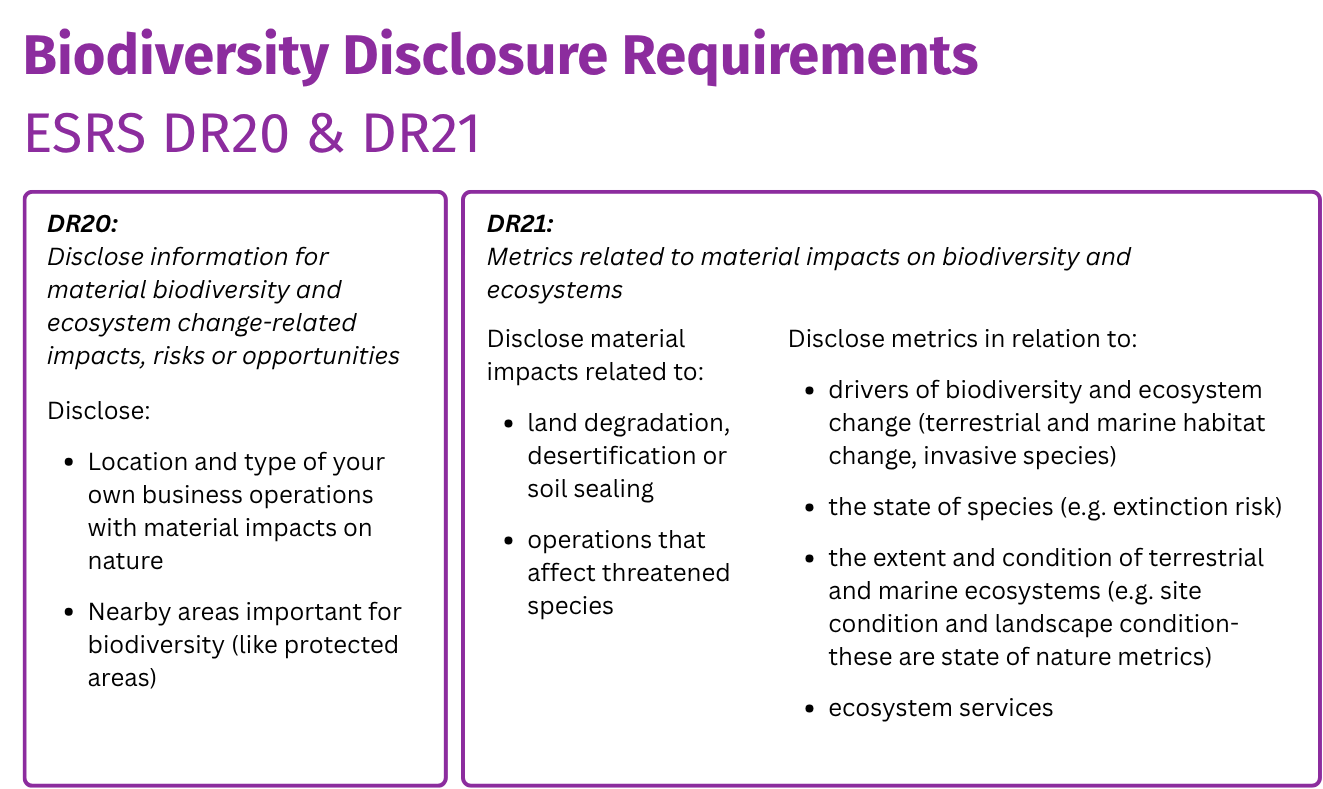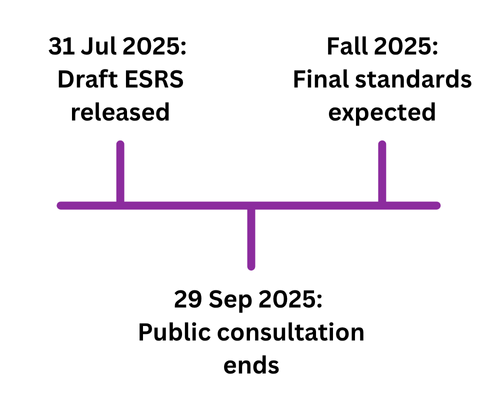ESRS E4 Simplified: What the New CSRD ESRS Biodiversity Reporting Draft Means for Your Business
Key Takeaways
While ESRS datapoints have been consolidated, the essence of the disclosure remains: companies must assess proximity to biodiversity sensitive areas
A bottom-up, location-based screening of company locations' proximity to biodiversity sensitive areas is part of the Double Materiality Assessment, to determine if Biodiversity and Ecosystems are material
The draft update now provides a definition of what "near" means, in terms of proximity to biodiversity sensitive areas
The European Commission (EC) took a major step towards making sustainability reporting more practical and accessible. In July 2025, EFRAG (The European Financial Reporting Advisory Group) released a draft of simplified sustainability reporting standards that cut required data points by 57% while preserving its core objectives. While sustainability advocates initially worried this simplification might weaken requirements, the European Sustainability Reporting Standard (ESRS) E4, Biodiversity and Ecosystems, proves otherwise—the E4 Standard is clearer and better aligned with major frameworks.
Why This Matters
Whether you're a small business owner or a sustainability manager at a multinational corporation, these changes will likely affect how you'll report on your environmental impact with CSRD.
Background
The Omnibus Simplification Package, released in February 2025, is a set of proposals aimed at streamlining and simplifying sustainability reporting requirements in the EU, including the Corporate Sustainability Reporting Directive (CSRD)’s ESRS. The goal of the Omnibus is to reduce the administrative burden on companies, particularly SMEs, while enhancing the EU’s competitiveness and facilitating the transition to a sustainable economy.
EFRAG is the technical advisor to the EC and was appointed to develop the initial ESRS. EFRAG was mandated by the EC to revise and simplify the ESRS and improve their overall usability.
Breaking Down the Draft Requirements
On July 31, EFRAG released its “exposure draft,” which is available for public consultation until September 29, 2025. The new simplified set of ESRS reduces datapoints by 57% while preserving its core objectives.
In this article, we focus on requirements related to biodiversity and ecosystems in ESRS 2, General Disclosures and ESRS E4, Biodiversity and Ecosystems. We are happy to see that, while the number of datapoints have decreased, the requirements have not weakened. Instead, they are easier to understand and align better with other major frameworks and initiatives, specifically the Taskforce on Nature-related Financial Disclosure (TNFD) and the Nature Positive Initiative’s (NPI’s) draft State of Nature metrics.
Note that the CSRD mandates that sustainability reports undergo independent verification by external auditors, just like how financial statements must be examined by outside accounting professionals to ensure their accuracy and reliability.
Disclosure Requirement ESRS 2- General Disclosures
The double materiality assessment is the starting point for sustainability reporting under ESRS, and ESRS 2 requires companies to “disclose its process to identify its impacts, risks and opportunities and to assess which ones are material." A crucial component of this identification process is screening site locations for “heightened risks of adverse environmental impacts.” This includes screening locations for their proximity to “threatened species and biodiversity sensitive areas” (Paragraph 26, AR 22). This screening is not a disclosure requirement that applies after a topic has been deemed material; rather, it is a required step within the process of identifying and assessing whether environmental impacts, including those related to biodiversity, are material. It is designed to help your company "identify the material impacts, risks and opportunities and the related topics to be reported" (ESRS 1, Paragraph 24).
ESRS 2 references the first three phases of the TNFD’s LEAP (Locate, Evaluate, Assess) approach as a helpful reference for “how to (i) locate where in own operations and along the value chain the interface with nature takes place, (ii) evaluate the dependencies and impacts, and (iii) assess risks and opportunities" (Paragraph 26, AR 22), showing greater alignment with the TNFD framework.
If, following this screening and the complete double materiality assessment process, your company concludes that biodiversity is not material, then you would omit the specific disclosures within ESRS E4 (Biodiversity and Ecosystems). However, this initial location-based screening process is a required part of determining that conclusion.
Disclosure Requirement ESRS E4-5: Metrics related to biodiversity and ecosystems change
The requirements for disclosing material biodiversity and ecosystem change-related impacts, risks, or opportunities was previously spread out across numerous Disclosure Requirements (DRs), but has been simplified into two – DR 20 and DR 21:
DR 20
Companies need to disclose the following information for material biodiversity and ecosystem change-related impacts, risks or opportunities:
the locations in its own operations to which the material impact, risks or opportunities relate;
for those locations, if applicable, a list of biodiversity-sensitive area(s) negatively affected (name and type); and
the activities negatively affecting those biodiversity-sensitive areas.
What 'Near' Actually Means (Finally!)
In additional information provided for DR 20, companies need to describe whether their sites are located in or near biodiversity-sensitive areas. The term “near” had been a point of confusion in the original ESRS E4 version, which EFRAG has now clarified in this draft. “Near” is determined by:
The ability of business activities to negatively impact species and ecosystems in the biodiversity sensitive area. This will depend on the type of activities that are occurring onsite. For example, an agricultural site with high water and fertilizer use will have a bigger impact on species and ecosystems than an office building.
A buffer zone specific to the type of business activity and species/ecosystems in the vicinity. ESRS E4 points to IBAT’s definitions for buffer zones, site-level findings, or other science-based recommendations. Generally speaking, industries with activities that have larger negative impacts on species and ecosystems should use a larger buffer zone than those with smaller impacts. According to IBAT’s guidance, in the example above, the agricultural site would use a buffer of 10km, while the office building would use a smaller buffer of 5 km.
Think of buffer zones like the ripple effect when you drop a stone in a pond – the bigger the stone (your business impact), the wider the ripples (your buffer zone should be).
The definition of “biodiversity sensitive areas” has been updated as well. These areas are defined as at least one of these types of sites:
Natura 2000 network of protected areas
Other protected areas, with the World Database on Protected Areas (WDPA) being the most comprehensive source
Key Biodiversity Areas (‘KBAs’)
Ecologically or Biologically Significant Marine Areas (EBSAs)
Habitats of species listed in IUCN Red List of Threatened Species (which are scientifically recognized for their importance for biodiversity)
DR 21
Companies need to report metrics related to material impacts on biodiversity and ecosystems.
Additional information for DR 21:
1. When providing a description of material impacts, risks and opportunities, companies must indicate which material impacts concern:
land degradation, desertification or soil sealing, and
operations that affect threatened species
2. Depending on which impacts are deemed to be material, companies need to disclose metrics in relation to:
drivers of biodiversity and ecosystem change (terrestrial and marine habitat change, invasive species);
the state of species (e.g. related to extinction risk);
the extent and condition of terrestrial and marine ecosystems (e.g. related to site condition and landscape condition); and
ecosystem services
3. Where possible, on-site measurement of state of nature metrics is best- this is particularly true for sites that are in or near biodiversity-sensitive areas. When on-site measurement is not feasible, estimation of impact drivers or estimates of state of nature can be used.
4. Companies are also guided to disclose the baseline condition, baseline year, and frequency of monitoring, as well as whether the chosen metrics allow users to understand how they relate to material impacts.
This guidance better aligns with the TNFD and NPI’s draft State of Nature metrics. These State of Nature metrics provide guidance on how to measure extent and condition of ecosystems, as well as describing options for both on-site and estimated measurement. Companies can refer to that guidance to fulfill the ESRS E4 requirements.
Timeline
The draft standards are open for public consultation, which closes on September 29, 2025. However, given that the updated ESRS E4 Standard better aligns with major frameworks such as the TNFD, it seems unlikely that the requirements will reduce in scope. Now is a good time to start understanding the metrics requirements and collecting your company’s relevant data.
Not sure how to navigate these CSRD biodiversity and ecosystems disclosure requirements? Our solution at Dunya Analytics is the fastest way to get started measuring nature and biodiversity. It enables you to easily understand your material impacts as they relate to biodiversity and ecosystems, assess your locations against biodiversity-sensitive areas, measure state of nature, and develop a robust reporting approach that meets CSRD requirements- in a fully transparent and auditable way. Contact us to learn more about our CSRD compliance solutions.


